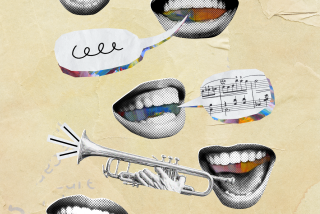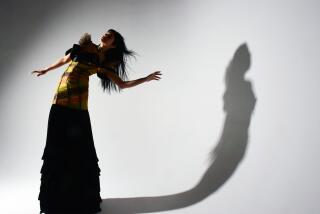Anoushka Shankar links songs of India and Spanish flamenco
For legendary Indian sitarist Ravi Shankar’s 75th birthday, a very special guest was invited onstage to perform with the onetime Beatles cohort.
Shankar’s accompanying orchestra members set down their instruments as she walked onto the New Dehli stage, sat down with her own sitar and performed a 15-minute solo set. In front of 2,500 people, Anoushka Shankar, Ravi’s daughter, had made her musical debut. She was 13.
“It was utterly terrifying,” Shankar says of her big premiere in 1995. “I don’t get nervous when I get onstage now, but that wasn’t a nice, safe concert, I’ll tell you that much.” Now the 30-year-old sitarist brings her mix of traditional Indian music with global rhythms to Southern California at the Luckman Fine Arts Complex on Saturday and Irvine Barclay Theater on Sunday.
Trained by her father, now 92, Shankar’s dexterous style pushes the boundaries of her instrument, meandering from the classical Indian ragas to whirlwind jazz to pop phrasing. In 2003, she was the youngest musician to be nominated for a world music Grammy Award, and three years later, Shankar was the first Indian musician to perform at the awards show.
On her latest album, “Traveller,” Shankar explores the relationship between the rapturous songs of India and the fiery rhythms of Spanish flamenco. “As a child, my father told me about theories connecting musical forms,” Shankar says. The unlikely pairing is based on a controversial idea: Spanish flamenco may have its roots in India.
More than a thousand years ago, as the story goes, pariah class migrants from the northwest Indian state of Rajasthan traversed Central Asia, crossed the Middle East, passed through Eastern Europe and eventually settled in what is now Spain. This gypsy diaspora, called the Roma, left remnants of Indian culture along the way. The songbird cadences of Indian music and the whirling dances of the Roma became infused in multicultural mélange of Andalusia.
Then 200 years ago, flamenco was built from the bones of Arab, Jewish and Christian musical traditions. India was a distant cousin, but its culture was in Spain’s blood. “In Indian music, we call it ‘spirituality,’ and in Spanish music, it’s ‘passion,’” Shankar says. “It’s really the same thing in both forms, that reaching at the deepest part of the human soul.”
Shankar had her first taste of flamenco while traveling to Spain in her late teens. By this time, she was rarely at her family’s home in Encinitas, Calif., instead traveling the world to perform with her father. But for this trip, she was on her own.
Shankar was crashing at musician Jackson Browne’s Barcelona apartment — he was a “friend of a friend,” she says — and he left her a note suggesting the best flamenco show in town. “It was a small, unknown flamenco bar,” she remembers, “with all these passionate people coming up onstage, dancing and singing along. It was electrifying. You can’t not be swept up by it.”
For “Traveller,” Shankar delved deeper into these sounds she heard in that dark bar. She returned to Spain and enlisted flamenco producer and guitarist Javier Limón to help develop the sound. In the studio, they would sit across from each other, Limón with his guitar, Shankar with a sitar, exploring the musical conversation between their instruments.
“The translation wasn’t literal,” Shankar says of these first sessions between the structurally divergent instruments. “There was no point in me making my sitar sound like a guitar. There would be a million guitarists who could do that better than I could. But for an Indian sitarist to reach out to flamenco and play from a different perspective, that’s what was interesting; to see what comes of that dialogue.”
Lyrically, “Traveller’s” songs traverse languages too. For two songs, Limón translated ancient Persian hymns into Spanish, on others Shankar wrote the lyrics in English first, and he translated them. “I actually feel more comfortable when my lyrics are in another language,” Shankar says, “I think in English more than any other language, so I think it’s good when my words are disguised a bit more. Spanish is a much more Romantic language in all senses of the word; it’s evocative.”
Limón and Shankar crafted an album that oscillates seamlessly between Indian and flamenco styles, shoring one influence upon another, bled together in a sound without borders. Tablas pop like castanets on “ISHQ”; Spanish flamenco cantaor Duquende’s vocals waver and soar like sitar notes on “Si No Puedo Verla”; and Shankar and pianist Ricardo Miño showdown on “Buleria Con Ricardo,” a frenetic duel that tap dances up and around scales. For “Dancing in Madness,” Shankar captured the sounds of a dance off.
“I recorded two dancers, a flamenco dancer and a bharata-natyam Indian dancer,” Shankar says, “so you hear their feet dueting on the piece. Both traditions have such incredible rhythms for the dancers, so it’s not just the music, we hear, we get to showcase the footwork too.”
After starting production on “Traveller,” Shankar was surprised by a bit of good news: She was pregnant. She finished the record just four weeks after her son was born. In the course of nine months she brought a child and an album into the world. “As I would play music, I could feel the connection to him. I would feel him in my belly, dancing.”
More to Read
The biggest entertainment stories
Get our big stories about Hollywood, film, television, music, arts, culture and more right in your inbox as soon as they publish.
You may occasionally receive promotional content from the Los Angeles Times.










